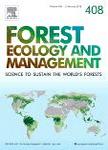版权所有:内蒙古大学图书馆 技术提供:维普资讯• 智图
内蒙古自治区呼和浩特市赛罕区大学西街235号 邮编: 010021

作者机构:Ohio State Univ Ohio Agr Res & Dev Ctr Sch Environm & Nat Resources Wooster OH 44691 USA Ohio State Univ Sch Environm & Nat Resources Columbus OH 43210 USA
出 版 物:《FOREST ECOLOGY AND MANAGEMENT》 (森林生态学与管理)
年 卷 期:2011年第261卷第3期
页 面:720-729页
核心收录:
学科分类:0907[农学-林学] 08[工学] 0829[工学-林业工程] 09[农学]
基 金:U.S.D.A. Forest Service Ohio Agricultural and Research Development Center School of Environment and Natural Resources The Ohio State University
主 题:Acer Eastern deciduous forest Quercus Southeastern Ohio Structural equation modeling (SEM) Unglaciated Allegheny Plateau
摘 要:Forest communities across the landscape of the Central Hardwood Forest Region are experiencing a transition from dominance by oak (Quercus) and hickory (Carya) to maple (Acer) driven largely by a prolonged period of fire suppression. In many cases, this shift in community composition, structure, and function is considered undesirable as oak-hickory forests are valued for timber, wildlife habitat, and natural heritage. Considerable management and restoration efforts target the restoration of oak-hickory forest communities, yet treatments have yielded varying degrees of success. In some cases, difficulties in meeting targets may be due to ecological thresholds created by complex vegetation-environment interactions that maintain the maple-dominated community state. We examined direct and indirect interactions among vegetation layers and environmental gradients for the mature, second-growth forest communities of the Ironton Unit of the Wayne National Forest (WNF) in southeastern Ohio. Using a stratified random approach, we identified 72 study communities with trees at least 70 years old and without evidence of recent disturbance. Within these communities, we sampled all overstory vegetation on two-four 500 m(2) plots and recorded saplings and ground-flora species in nested sub-plots. At each plot, we also collected soil samples for physical and chemical analyses and recorded physiographic variables. Our first objective was to describe the Ironton forest landscape, where communities were likely transitioning from oak to maple. To identify such patterns, we used ordination analyses that relate species occurrence to implied environmental gradients. Our second objective was to use the relationships to develop a structural equation model (SEM) to quantify the strength of pathways among the canopy, sapling, and ground-flora vegetation layers and environmental factors (e.g., soil chemistry and physiographic position). Our results indicate that the forest landscape of the Iront